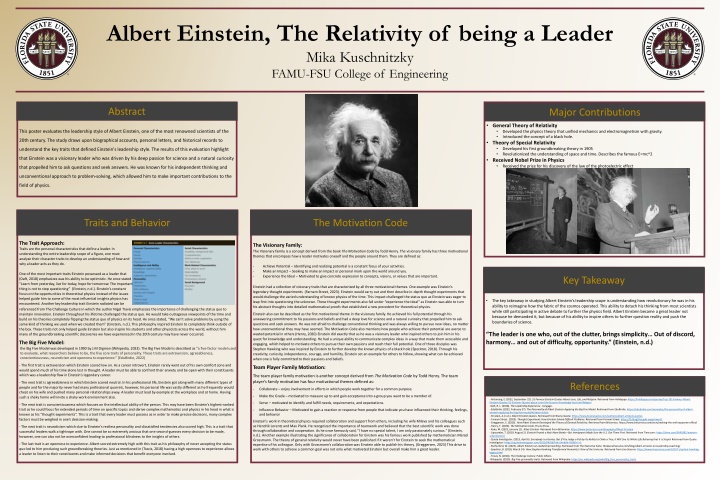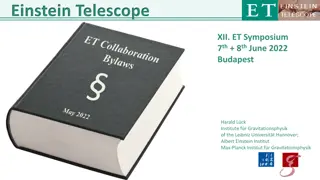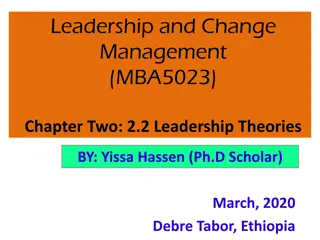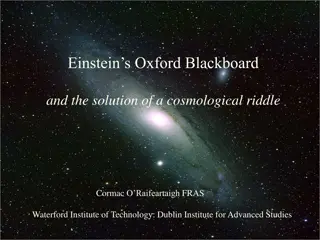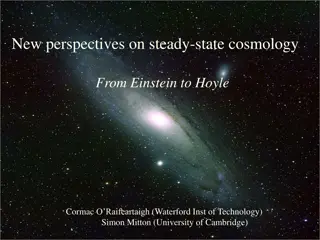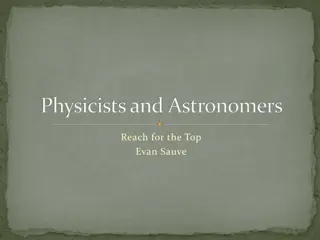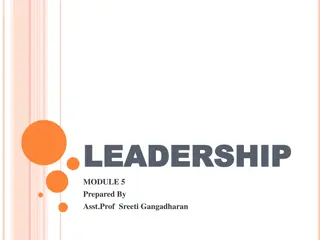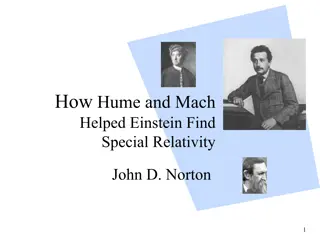Leadership Traits of Albert Einstein: A Visionary Analysis
Explore Albert Einstein's leadership style through a visionary lens, highlighting his traits, motivations, and revolutionary impact on the field of physics. Discover how his optimism, thought experiments, and challenge culture influenced his leadership approach and inspired others to redefine scientific boundaries.
Download Presentation

Please find below an Image/Link to download the presentation.
The content on the website is provided AS IS for your information and personal use only. It may not be sold, licensed, or shared on other websites without obtaining consent from the author.If you encounter any issues during the download, it is possible that the publisher has removed the file from their server.
You are allowed to download the files provided on this website for personal or commercial use, subject to the condition that they are used lawfully. All files are the property of their respective owners.
The content on the website is provided AS IS for your information and personal use only. It may not be sold, licensed, or shared on other websites without obtaining consent from the author.
E N D
Presentation Transcript
Albert Einstein, The Relativity of being a Leader Mika Kuschnitzky FAMU-FSU College of Engineering Abstract Major Contributions General Theory of Relativity Developed the physics theory that unified mechanics and electromagnetism with gravity. Introduced the concept of a black hole. Theory of Special Relativity Developed his first groundbreaking theory in 1905 Revolutionized the understanding of space and time. Describes the famous E=mc^2 Received Nobel Prize in Physics Received the prize for his discovery of the law of the photoelectric effect This poster evaluates the leadership style of Albert Einstein, one of the most renowned scientists of the 20th century. The study draws upon biographical accounts, personal letters, and historical records to understand the key traits that defined Einstein's leadership style. The results of this evaluation highlight that Einstein was a visionary leader who was driven by his deep passion for science and a natural curiosity that propelled him to ask questions and seek answers. He was known for his independent thinking and unconventional approach to problem-solving, which allowed him to make important contributions to the field of physics. Traits and Behavior The Motivation Code The Trait Approach: Traits are the personal characteristics that define a leader. In understanding the entire leadership scope of a figure, one must analyze their character traits to develop an understanding of how and why a leader acts as they do. The Visionary Family: The Visionary family is a concept derived from the book The Motivation Code by Todd Henry. The visionary family has three motivational themes that encompass how a leader motivates oneself and the people around them. They are defined as: - - - Achieve Potential Identifying and realizing potential is a constant focus of your activities. Make an Impact Seeking to make an impact or personal mark upon the world around you. Experience the Ideal Motivated to give concrete expression to concepts, visions, or values that are important. One of the most important traits Einstein possessed as a leader that (Daft, 2018) emphasizes was his ability to be optimistic. He once stated Learn from yesterday, live for today, hope for tomorrow. The important thing is not to stop questioning (Einstein, n.d.). Einstein s constant focus on the opportunities in theoretical physics instead of the issues helped guide him to some of the most influential insights physics has encountered. Another key leadership trait Einstein radiated can be Key Takeaway Einstein had a collection of visionary traits that are characterized by all three motivational themes. One example was Einstein s legendary thought experiments (Farnam Street, 2023). Einstein would carry out and then describe in-depth thought experiments that would challenge the varied understanding of known physics of the time. This impact challenged the status quo as Einstein was eager to leap first into questioning the unknown. These thought experiments also fall under experience the ideal as Einstein was able to turn his abstract thoughts into detailed mathematical proofs that established a new precedent for theoretical physics. The key takeaway in studying Albert Einstein s leadership scope is understanding how revolutionary he was in his ability to reimagine how the fabric of the cosmos operated. This ability to detach his thinking from most scientists while still participating in active debate to further the physics field. Albert Einstein became a great leader not because he demanded it, but because of his ability to inspire others to further question reality and push the boundaries of science. referenced from The Challenge Culture in which the author Nigel Travis emphasizes the importance of challenging the status quo to maintain innovation. Einstein throughout his lifetime challenged the status quo. He would take outrageous viewpoints of the time and build on his theories completely flipping the status quo of physics on its head. He once stated, We can t solve problems by using the same kind of thinking we used when we created them (Einstein, n.d.). This philosophy inspired Einstein to completely think outside of the box. These traits not only helped guide Einstein but also inspire his students and other physicists across the world, without him many of the groundbreaking scientific discoveries we have experienced in the 20th century may have never occurred. Einstein also can be described as the first motivational theme in the visionary family. He achieved his full potential through his unwavering commitment to his passions and beliefs and had a deep love for science and a natural curiosity that propelled him to ask questions and seek answers. He was not afraid to challenge conventional thinking and was always willing to pursue new ideas, no matter how unconventional they may have seemed. The Motivation Code also mentions how people who achieve their potential are averse to wasted potential in others (Henry, 2020) Einstein did exactly that as he was a visionary leader who inspired others to join him in his quest for knowledge and understanding. He had a unique ability to communicate complex ideas in a way that made them accessible and engaging, which helped to motivate others to pursue their own passions and reach their full potential. One of those disciples was Stephen Hawking who was inspired by Einstein to further develop the known physics of a black hole (Specktor, 2018). Through his creativity, curiosity, independence, courage, and humility, Einstein set an example for others to follow, showing what can be achieved when one is fully committed to their passions and beliefs. The leader is one who, out of the clutter, brings simplicity Out of discord, harmony and out of difficulty, opportunity. (Einstein, n.d.) The Big Five Model: the Big Five Model was developed in 1990 by J.M Digman (Wikipedia, 2023). The Big Five Model is described as a five-factor model used to evaluate, what researchers believe to be, the five core traits of personality. These traits are extraversion, agreeableness, conscientiousness, neuroticism and openness to experience. (EduBirdie, 2022) - The first trait is extraversion which Einstein scored low on. As a career introvert, Einstein rarely went out of his own comfort zone and would spend much of his time alone lost in thought. A leader must be able to confront their anxiety and be open with their constituents which was a leadership flaw in Einstein s legendary career. Team Player Family Motivation: The team player family motivation is another concept derived from The Motivation Code by Todd Henry. The team player s family motivation has four motivational themes defined as: Daft, R. (2011). The Leadership Experience, Sixth Edition. - The next trait is agreeableness in which Einstein scored neutral. In his professional life, Einstein got along with many different types of people and for the majority never had many professional quarrels, however, his personal life was vastly different as he frequently would cheat on his wife and pushed many personal relationships away. A leader must lead by example at the workplace and at home. Having such a shaky home will invite a shaky work environment also. References - Collaborate enjoy involvement in efforts in which people work together for a common purpose. - Make the Grade motivated to measure up to and gain acceptance into a group you want to be a member of. - Aritonang, E. (2022, September 22). 51 Famous Einstein Quotes About Love, Life, and Religion. Retrieved from Holidappy: https://holidappy.com/quotes/Top-101-Famous-Albert- Einstein-Quotes-51-Einstein-Quotes-about-Love-Life-Success-Knowledge-God-and-Religion -Daft, R. L. (2018). The Leadership Experience . Cengage. - EduBirdie. (2022, February 27). The Personality of Albert Einstein Applying the Big Five Model. Retrieved from EduBirdie: https://edubirdie.com/examples/the-personality-of-albert- einstein-applying-the-big-five-model/#citation-block - Einstein, A. (n.d.). Albert Einstein Quotes. Retrieved from Brainy Quote: https://www.brainyquote.com/authors/albert-einstein-quotes - Farnam Street. (2023). Thought Experiment: How Einstein Solved Difficult Problems. Retrieved from Farnam Street: https://fs.blog/thought-experiment/ - Greggersen, E. (2023). How Albert Einstein Developed the Theory of General Relativity. Retrieved from Britannica: https://www.britannica.com/story/making-the-anthropocene-official - Henry, T. (2020). The Motivation Code. Pruvio Press . - Kaku, M. (2023, January 11). Alber Einstein. Retrieved from Britannica: https://www.britannica.com/biography/Albert-Einstein - Lipscombe, T. (2019, August 2). Einstein Feared a Nazi Atom Bomb But Immigrants Made Sure the U.S. Got There First. Retrieved from Time.com: https://time.com/5641891/einstein- szilard-letter/ - Quote Investigator. (2013, April 6). Everybody is a Genius. But If You Judge a Fish by Its Ability to Climb a Tree, It Will Live Its Whole Life Believing that It is Stupid. Retrieved from Quote Investigator: https://quoteinvestigator.com/2013/04/06/fish-climb/#r+5880+1+2 - Rutherford, W. (2023). Albert Einstein on Leadership Coaching. Retrieved from The Executive Suite: theexecutivesuite.com/blog/albert-einstein-on-leadership-coaching/ - Specktor, B. (2018, March 14). How Stephen Hawking Transformed Humanity's View of the Universe. Retrieved from Live Science: https://www.livescience.com/62017-stephen-hawking- legacy.html - Travis, N. (2018). The Challenge Culture. Public Affairs. -Wikipedia. (2023). Big Five personality traits. Retrieved from Wikipedia: https://en.wikipedia.org/wiki/Big_Five_personality_traits - Serve motivated to identify and fulfill needs, requirements, and expectations. - The next trait is conscientiousness which focuses on the intellectual ability of the person. This may have been Einstein s highest-ranked trait as he could focus for extended periods of time on specific topics and derive complex mathematics and physics in his head in what is known as his thought experiments . This is a trait that every leader must possess as in order to make precise decisions, many complex factors must be weighed in one s decision-making. - Influence Behavior Motivated to gain a reaction or response from people that indicate you have influenced their thinking, feelings, and behavior Einstein's work in theoretical physics required collaboration and support from others, including his wife Mileva and his colleagues such as Hendrik Lorentz and Max Plank. He recognized the importance of teamwork and believed that the best scientific work was done through collaboration and cooperation. As he once famously said, "I have no special talent, I am only passionately curious." (Einstein, n.d.). Another example illustrating the significance of collaboration for Einstein was his famous work published by mathematician Marcel Grossmann. The theory of general relativity would never have been published if it weren t for Einstein to seek the mathematical expertise of his colleague. Only with Grossmann s collaboration was Einstein able to publish his theory. (Greggersen, 2023) This drive to work with others to achieve a common goal was not only what motivated Einstein but overall make him a great leader. - The next trait is neuroticism which due to Einstein s restless personality and dissatisfied tendencies also scored high. This is a trait that successful leaders walk a tightrope with. One cannot be so extremely anxious that one second-guesses every decision to be made, however, one can also not be overconfident leading to professional blindness to the insights of others. - The last trait is an openness to experience. Albert scored extremely high with this trait as his philosophy of never accepting the status quo led to him producing such groundbreaking theories. Just as mentioned in (Travis, 2018) having a high openness to experience allows a leader to listen to their constituents and make informed decisions that benefit everyone involved.
